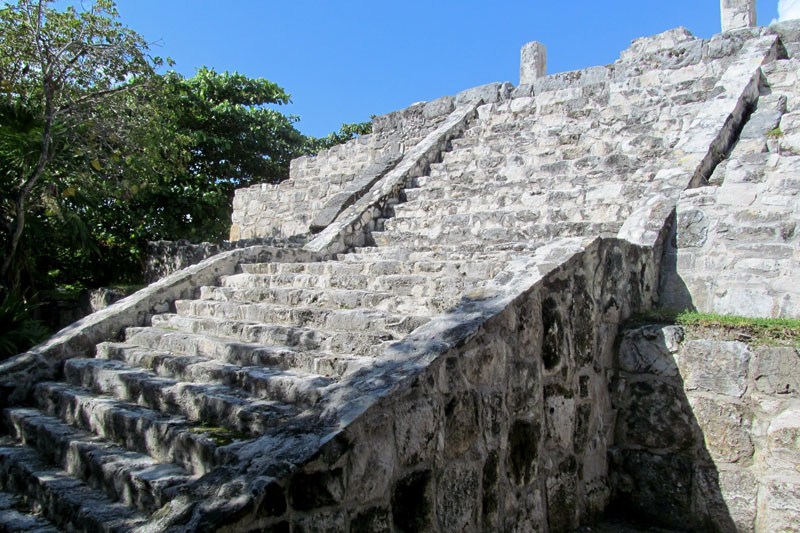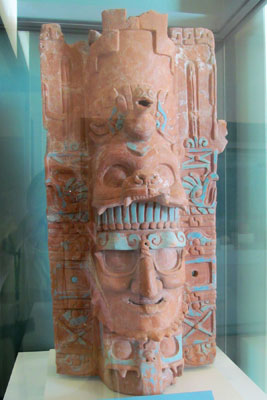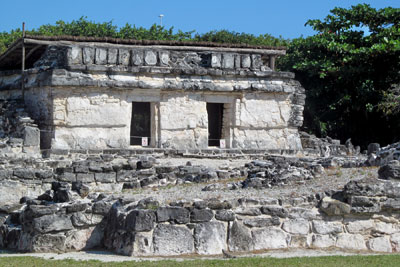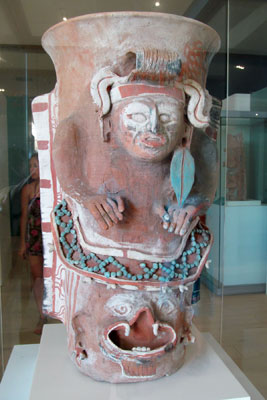Beyond the beach — archaeological sites in Cancún
This item appears on page 60 of the January 2015 issue.
Green-blue water. White-sand beaches. Posh hotels. Gourmet dining. Vibrant nightlife. This is what most visitors to Cancún travel there for. Few know that this sybaritic tourist mecca on Mexico’s northwest Yucatán coast was also once home to the Maya, as was the rest of the Yucatán Peninsula.
Many visitors seek out the Yucatán’s best-known archaeological sites at Chichen Itza, Uxmal and Tulum, this last site about 80 miles south of Cancún, little guessing that there are Mayan ruins in their own holiday backyard.
On my trip to Cancún in February 2014, my husband, Paul, and I visited three of these “neighborhood” Mayan sites. Granted, none of the three have either the reputation or the panache of sites like Tulum, but each proved to be a miniature archaeological gem. Plus, how often can you climb a Mayan pyramid in the morning and swim in the Caribbean the same afternoon?
El Meco’s three plazas
El Meco, located 3½ miles north of central Cancún, is a good example of the Mayan villages that once flourished in this corner of the Yucatán. It probably originated in the Early Classic period between AD 300 and 600 as a self-sufficient fishing community. For unknown reasons — perhaps famine, warfare or disease — the site was abandoned around 600.
Sometime after 1000 to 1100, El Meco was resettled, flourishing again for the next few hundred years as part of a wide-ranging network of fishing and trading communities in northwestern Yucatán. This lasted until the arrival of the Spaniards in the 16th century.
The portion of the El Meco site that’s been excavated is small, comprising three plazas arranged around a 4-tiered, 40-foot-high pyramid called El Castillo.
The principal plaza, Plaza A, was probably where most civil and ceremonial activities took place, as evidenced by the altar placed in front of the pyramid’s main staircase.
Plaza B, south of Plaza A, is bordered by two palaces that could have been civic buildings or, perhaps, residences for the ruling elite.
Plaza C, north of Plaza A, is dominated by a long building on a low platform with columns that once supported a roof. This building could have served as a residential palace for El Meco’s rulers.
El Meco is open daily from 8 to 5. The admission charge is 43 pesos, or about $3.30 at the time of our visit.
El Rey’s “Main Street”
Southeast of central Cancún, El Rey is located in the shoulder-to-shoulder high-rise hotel zone on Boulevard Kukulkan at km. 17.5. Some modern pyramid-shaped hotels can be seen from the archaeological site.
El Rey, like El Meco, may have originated in the fourth century AD, but it grew in importance from 1250 to 1550, the Late Postclassic period. It was abandoned when the Spaniards arrived. But in its heyday of 300 years, El Rey — with a prime position between the Caribbean and the Nichupte Lagoon — was an important trading settlement, bartering its turtle shells for knives, obsidian and jade from other parts of Mexico and beyond.
The archaeological site is long and narrow, with a central plaza dominated by a pyramid. A calzada, or avenue, runs from the site entrance north to this pyramid, with buildings on raised platforms lining both sides.
These buildings, many with columns, galleries and benches lining the interiors, were once temples and palaces. One can imagine how impressive it must have been to walk along this avenue to reach the central pyramid.
Close to the pyramid stands Structure 4, a 2-tiered building with two staircases and 18 columns that once supported a roof. El Rey’s ruling class probably lived there as well as ruled from there. Today it is home to dozens of fat iguanas, which bask on the sun-soaked stones. El Rey is iguana heaven. I saw more there than at any other archaeological site in my six weeks in the Yucatán.
El Rey is open daily from 8 to 5. The admission charge is 48 pesos ($3.70).
San Miguelito and a new museum
Also situated in the hotel zone on Boulevard Kukulkan, at km. 16, is San Miguelito, named for a coconut ranch that stood there in the 1950s. This site, like El Meco and El Rey, was important as part of the Mayan trading network in the years 1250 to 1550. It was a complex of temples, shrines and palaces ranged along a road that paralleled the coast — similar to El Rey — and may even have been part of El Rey, although no one knows for sure.
Today, a trail leads to a small number of excavated sites in the dense jungle and to a squat, 26-foot-high pyramid. Surrounding these sites are mounds beneath which lie unexplored ruins that could be temples or shrines or merely the bases of more modest dwellings of wood or palm leaf that long ago surrendered to the jungle.
San Miguelito is on the grounds of the new Museo Maya de Cancún, which opened in November 2012. The museum, a strikingly austere building elevated 30 feet over the ground as a precaution against flooding during hurricanes, exhibits jade masks, elaborate incense burners, stone stele and ceramics from archaeological sites throughout Mayan Yucatán.
San Miguelito and Museo Maya are both open Tuesday to Sunday, 9 to 6. Admission costs 59 pesos ($4.50) for both the site and museum. To verify hours, it’s best to call (in Cancún) 998 885 3842 in advance of visiting.
It’s possible to visit all three archaeological sites and the museum in one busy day, but I don’t recommend it. Because of the heat, even in February when we visited, I opted for one archaeological site on each of three different mornings.
Not including travel time, each site can easily be seen in about an hour. Allow about 1½ hours for the museum, saving it for a hot afternoon, since it’s air-conditioned.
If you go…
We didn’t want to spend our 10 days in Cancún in a glitzy high-rise hotel. Rental homes are hard to come by in the Cancún area, but we found a beautiful one through VRBO.com (listing No. 422097). It was a very comfortable, 3-bedroom, 3-bathroom house on Boulevard Kukulkan at km. 6.5, on Playa Tortuga.
There was a large upstairs balcony and an even larger ground-level terrace, both overlooking the Caribbean. Best of all was the private pool. From the terrace, a gate opened to the vest-pocket beach and the azure waters of the Caribbean. This was heaven for us, especially as we heard daily reports from home about the snowstorms battering New York City.
Rent for this bit of paradise was $350 per day.




